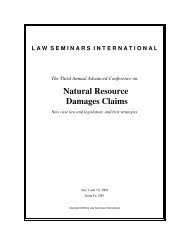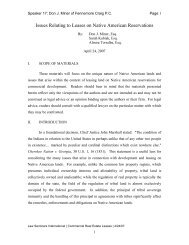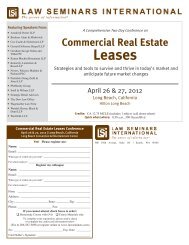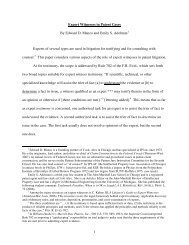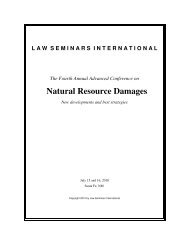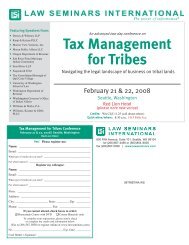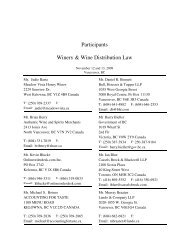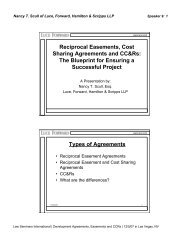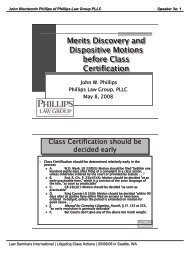Oregon State Taxes and their Effects on Tribes and Tribal Members
Oregon State Taxes and their Effects on Tribes and Tribal Members
Oregon State Taxes and their Effects on Tribes and Tribal Members
You also want an ePaper? Increase the reach of your titles
YUMPU automatically turns print PDFs into web optimized ePapers that Google loves.
Tom S. Stinnette of <str<strong>on</strong>g>Oreg<strong>on</strong></str<strong>on</strong>g> Department of Revenue Speaker 6b: 1<br />
<str<strong>on</strong>g>Oreg<strong>on</strong></str<strong>on</strong>g> <str<strong>on</strong>g>State</str<strong>on</strong>g> <str<strong>on</strong>g>Taxes</str<strong>on</strong>g> <str<strong>on</strong>g>and</str<strong>on</strong>g> <str<strong>on</strong>g>their</str<strong>on</strong>g><br />
<str<strong>on</strong>g>Effects</str<strong>on</strong>g> <strong>on</strong> <strong>Tribes</strong> <str<strong>on</strong>g>and</str<strong>on</strong>g> <strong>Tribal</strong><br />
<strong>Members</strong><br />
<str<strong>on</strong>g>Oreg<strong>on</strong></str<strong>on</strong>g> Department of Revenue<br />
February<br />
Law Seminars Internati<strong>on</strong>al | Tax Management for <strong>Tribes</strong> | 02/21/08 in Seattle, WA
Tom S. Stinnette of <str<strong>on</strong>g>Oreg<strong>on</strong></str<strong>on</strong>g> Department of Revenue Speaker 6b: 2<br />
Tribe Enrollment Reservati<strong>on</strong> & L<str<strong>on</strong>g>and</str<strong>on</strong>g> in Trust Acreage<br />
Total County<br />
Burns Paiute 343 13,736 Harney 13,736<br />
C<strong>on</strong>federated <strong>Tribes</strong> of Gr<str<strong>on</strong>g>and</str<strong>on</strong>g> R<strong>on</strong>de 4,956 11,040<br />
Yamhill Polk<br />
C<strong>on</strong>federated <strong>Tribes</strong> of Siletz 4,242 4,204 Lincoln 4,204<br />
C<strong>on</strong>federated <strong>Tribes</strong> of Umatilla 2,530 172,882<br />
Umatilla Uni<strong>on</strong><br />
C<strong>on</strong>federated <strong>Tribes</strong> of Warm Springs 4,400 644,000 Clackamas<br />
Jeffers<strong>on</strong>Linn<br />
Mari<strong>on</strong>Wasco<br />
Acres<br />
10,800<br />
240<br />
171.882<br />
1,000<br />
12,865<br />
236,082<br />
6 4,170<br />
390,877<br />
Coquille Indian Tribe 840 6,512 Coos 6,512<br />
Cow Creek B<str<strong>on</strong>g>and</str<strong>on</strong>g> of Umpqua Indians 1,374 3,235.96 Douglas 3,235.96<br />
C<strong>on</strong>federated <strong>Tribes</strong> of Coos, Lower<br />
Umpqua & Siuslaw<br />
807 127.4 Coos 127.4<br />
Klamath <strong>Tribes</strong> 3,592 390 Klamath 390<br />
Ft. McDermitt (mostly in Nevada) N/A 18,269 Malheur 18,629<br />
Law Seminars Internati<strong>on</strong>al | Tax Management for <strong>Tribes</strong> | 02/21/08 in Seattle, WA
Tom S. Stinnette of <str<strong>on</strong>g>Oreg<strong>on</strong></str<strong>on</strong>g> Department of Revenue Speaker 6b: 3<br />
<str<strong>on</strong>g>Oreg<strong>on</strong></str<strong>on</strong>g> Department of Revenue<br />
<strong>Tribal</strong> Relati<strong>on</strong>s Policy<br />
(Adopted under ORS 182.164)<br />
Policy <str<strong>on</strong>g>State</str<strong>on</strong>g>ment<br />
The <str<strong>on</strong>g>State</str<strong>on</strong>g> of <str<strong>on</strong>g>Oreg<strong>on</strong></str<strong>on</strong>g> recognizes the sovereign status of the nine federally recognized Indian tribal<br />
governments located in the <str<strong>on</strong>g>State</str<strong>on</strong>g> of <str<strong>on</strong>g>Oreg<strong>on</strong></str<strong>on</strong>g>. The Department of Revenue will work with<br />
representatives of the tribal sovereigns to clearly articulate <str<strong>on</strong>g>Oreg<strong>on</strong></str<strong>on</strong>g> tax policy, identify other areas of<br />
mutual interest, <str<strong>on</strong>g>and</str<strong>on</strong>g> ensure a “key c<strong>on</strong>tact” is identified <str<strong>on</strong>g>and</str<strong>on</strong>g> accessible to all parties.<br />
<strong>Tribal</strong> Key C<strong>on</strong>tact<br />
A member of the department’s Management Team will serve as “tribal key c<strong>on</strong>tact” <str<strong>on</strong>g>and</str<strong>on</strong>g> be<br />
resp<strong>on</strong>sible for coordinati<strong>on</strong> with tribal governments. The key c<strong>on</strong>tact will work with department<br />
staff <str<strong>on</strong>g>and</str<strong>on</strong>g> designated tribal representatives to identify state policies <str<strong>on</strong>g>and</str<strong>on</strong>g> programs that affect tribal<br />
interests. The c<strong>on</strong>tact will coordinate with department managers to ensure employees recognize the<br />
importance of working with tribal representatives <str<strong>on</strong>g>and</str<strong>on</strong>g> respecting tribal sovereignty <str<strong>on</strong>g>and</str<strong>on</strong>g> rights. The<br />
department will strive to design soluti<strong>on</strong>s <str<strong>on</strong>g>and</str<strong>on</strong>g> develop programs that will achieve mutual goals.<br />
Programs Affected<br />
The department interacts with the tribal nati<strong>on</strong>s in a variety of areas affecting taxati<strong>on</strong>. In pers<strong>on</strong>al<br />
income tax, the department collects debts owed by individual working for the tribes. This may<br />
include taking collecti<strong>on</strong> acti<strong>on</strong>, such as garnishment of employees’ wages. In the area of cigarette<br />
tax, we have negotiated cigarette tax agreements with most <str<strong>on</strong>g>Oreg<strong>on</strong></str<strong>on</strong>g> <strong>Tribes</strong>. While tribal members are<br />
exempt, the agreements help ensure that n<strong>on</strong>-tribal members buying cigarettes <strong>on</strong> tribal l<str<strong>on</strong>g>and</str<strong>on</strong>g> pay the<br />
cigarette tax. In two other major areas, the department <str<strong>on</strong>g>and</str<strong>on</strong>g> the tribes are coordinating <strong>on</strong> property<br />
tax <str<strong>on</strong>g>and</str<strong>on</strong>g> corporati<strong>on</strong> tax issues.<br />
As we interact with the tribes, the department works to meet the m<str<strong>on</strong>g>and</str<strong>on</strong>g>ates of ORS 182.165 (3): “A<br />
state agency shall make a reas<strong>on</strong>able effort to cooperate with tribes in the development <str<strong>on</strong>g>and</str<strong>on</strong>g><br />
implementati<strong>on</strong> of programs of the state agency that affect tribes, including the use of agreements<br />
authorized by ORS 190.110.” We also participate in the Ec<strong>on</strong>omic Development cluster under the<br />
Government to Government umbrella.<br />
Communicati<strong>on</strong>s <str<strong>on</strong>g>and</str<strong>on</strong>g> Positive Relati<strong>on</strong>s<br />
The Department of Revenue seeks to promote positive government-to-government relati<strong>on</strong>s with<br />
<str<strong>on</strong>g>Oreg<strong>on</strong></str<strong>on</strong>g>’s federally recognized tribes by:<br />
• Interacting with the tribes in a spirit of mutual respect;<br />
• Seeking to underst<str<strong>on</strong>g>and</str<strong>on</strong>g> the varying tribal perspectives;<br />
• Facilitating communicati<strong>on</strong>, underst<str<strong>on</strong>g>and</str<strong>on</strong>g>ing, <str<strong>on</strong>g>and</str<strong>on</strong>g> appropriate dispute resoluti<strong>on</strong> with the tribes;<br />
• Working towards a shared visi<strong>on</strong> in areas of mutual interest, through the Government to<br />
Government process.<br />
Notifying Employees of the Policy<br />
Up<strong>on</strong> adopti<strong>on</strong>, the department will distribute this policy <str<strong>on</strong>g>and</str<strong>on</strong>g> the underlying statutes to<br />
employees who work with the tribes. We will also incorporate the policy into the<br />
department’s policy manual <str<strong>on</strong>g>and</str<strong>on</strong>g> post it <strong>on</strong> the department’s internal website for all<br />
employees.<br />
Law Seminars Internati<strong>on</strong>al | Tax Management for <strong>Tribes</strong> | 02/21/08 in Seattle, WA
Tom S. Stinnette of <str<strong>on</strong>g>Oreg<strong>on</strong></str<strong>on</strong>g> Department of Revenue Speaker 6b: 4<br />
316.777 Income derived from sources within federally recognized Indian country<br />
exempt from tax. (1) Any income derived from sources within the boundaries of<br />
federally recognized Indian country in <str<strong>on</strong>g>Oreg<strong>on</strong></str<strong>on</strong>g> by any enrolled member of a federally<br />
recognized American Indian tribe residing in federally recognized Indian country in<br />
<str<strong>on</strong>g>Oreg<strong>on</strong></str<strong>on</strong>g> at the time the income is earned is exempt from tax under this chapter.<br />
(2) An extract from the tribal rolls or other documentary proof of the taxpayer’s<br />
enrolled status <str<strong>on</strong>g>and</str<strong>on</strong>g> other additi<strong>on</strong>al proofs as may be required by the Department of<br />
Revenue, shall be attached to or accompany any return for any year for which exempti<strong>on</strong><br />
under subsecti<strong>on</strong> (1) of this secti<strong>on</strong> is claimed. The requirement of proof may be waived<br />
partially, c<strong>on</strong>diti<strong>on</strong>ally or absolutely, as provided under ORS 315.063. [Formerly<br />
316.049; 1985 c.317 §1; 1995 c.54 §17]<br />
Exempt Income of Native Americans<br />
(1) ORS 150-316.777 exempts from <str<strong>on</strong>g>Oreg<strong>on</strong></str<strong>on</strong>g> taxati<strong>on</strong> certain income earned by an<br />
enrolled member of a federally recognized Indian tribe. To qualify under these<br />
provisi<strong>on</strong>s, at the time the income is earned the tribal member must reside in "Indian<br />
country" in <str<strong>on</strong>g>Oreg<strong>on</strong></str<strong>on</strong>g>, <str<strong>on</strong>g>and</str<strong>on</strong>g> the income must be derived from sources within Indian country<br />
in <str<strong>on</strong>g>Oreg<strong>on</strong></str<strong>on</strong>g>. A tribal member who resides outside of Indian country can not exclude<br />
income from <str<strong>on</strong>g>Oreg<strong>on</strong></str<strong>on</strong>g> tax under the provisi<strong>on</strong>s of ORS 316.777. The pers<strong>on</strong> is subject to<br />
the statutes <str<strong>on</strong>g>and</str<strong>on</strong>g> rules governing <str<strong>on</strong>g>Oreg<strong>on</strong></str<strong>on</strong>g> residents <str<strong>on</strong>g>and</str<strong>on</strong>g> n<strong>on</strong>residents <str<strong>on</strong>g>and</str<strong>on</strong>g> is taxed<br />
accordingly.<br />
(2) Definiti<strong>on</strong>s: For purposes of this rule:<br />
(a) "Current reservati<strong>on</strong> boundaries" means the boundaries in existence at the time of the<br />
transacti<strong>on</strong>.<br />
(b) "Indian country" means any federally recognized Indian reservati<strong>on</strong> in <str<strong>on</strong>g>Oreg<strong>on</strong></str<strong>on</strong>g> or<br />
other l<str<strong>on</strong>g>and</str<strong>on</strong>g> in <str<strong>on</strong>g>Oreg<strong>on</strong></str<strong>on</strong>g> that has been set aside for the residence of tribal Indians under<br />
federal protecti<strong>on</strong>, <str<strong>on</strong>g>and</str<strong>on</strong>g> includes:<br />
(A) Any l<str<strong>on</strong>g>and</str<strong>on</strong>g> within the current reservati<strong>on</strong> boundaries of a federally recognized<br />
reservati<strong>on</strong> regardless of ownership.<br />
(B) <strong>Tribal</strong>- or member-owned l<str<strong>on</strong>g>and</str<strong>on</strong>g> outside current reservati<strong>on</strong> boundaries if held in trust<br />
for the benefit of the tribe or its members.<br />
Law Seminars Internati<strong>on</strong>al | Tax Management for <strong>Tribes</strong> | 02/21/08 in Seattle, WA
Tom S. Stinnette of <str<strong>on</strong>g>Oreg<strong>on</strong></str<strong>on</strong>g> Department of Revenue Speaker 6b: 5<br />
(C) L<str<strong>on</strong>g>and</str<strong>on</strong>g> that the federal government allotted to a tribal member that since the time of the<br />
allotment has been c<strong>on</strong>tinuously either:<br />
(i) Held in trust by the federal government for the benefit of an individual tribal<br />
member(s), i.e. a trust allotment; or<br />
(ii) Owned by a tribal member(s) with c<strong>on</strong>tinuing federal restricti<strong>on</strong>s against sale of the<br />
l<str<strong>on</strong>g>and</str<strong>on</strong>g>, i.e., a restricted allotment.<br />
(3) Income derived from sources within Indian country includes:<br />
(a) Wages earned for work performed in Indian country;<br />
(b) Income from a business or real estate located in Indian country;<br />
(c) Distributi<strong>on</strong>s, including earnings, from retirement plans, if the c<strong>on</strong>tributi<strong>on</strong>s to the<br />
plan were derived from or c<strong>on</strong>nected with services performed in Indian country;<br />
(d) Unemployment compensati<strong>on</strong>, if the benefits are received as a result of work<br />
performed in Indian country;<br />
(e) Interest, dividends, capital gain from the sale of stock, <str<strong>on</strong>g>and</str<strong>on</strong>g> other income from<br />
intangibles regardless of the locati<strong>on</strong> of the bank accounts or other intangible assets.<br />
(4) To be exempted from <str<strong>on</strong>g>Oreg<strong>on</strong></str<strong>on</strong>g> pers<strong>on</strong>al income tax withholding, a tribal member<br />
whose wages are exempt from <str<strong>on</strong>g>Oreg<strong>on</strong></str<strong>on</strong>g> tax must furnish the member's employer with an<br />
extract from the tribal rolls as proof of enrolled status. Any employer of a qualified<br />
exempt tribal member who has documentary proof under this rule must keep this proof as<br />
part of the employer's payroll records.<br />
(5) The following examples illustrate the provisi<strong>on</strong>s of this rule:<br />
Example 1: Margaret, an enrolled member of the C<strong>on</strong>federated <strong>Tribes</strong> of Warm Springs,<br />
lives <str<strong>on</strong>g>and</str<strong>on</strong>g> works <strong>on</strong> the reservati<strong>on</strong> of the C<strong>on</strong>federated <strong>Tribes</strong> of the Umatilla Indian<br />
Reservati<strong>on</strong>. Under ORS 316.777, her income is exempt from state income tax.<br />
Example 2: Claire, an enrolled member of the Coquille Indian Tribe, resides <strong>on</strong><br />
reservati<strong>on</strong> l<str<strong>on</strong>g>and</str<strong>on</strong>g> in <str<strong>on</strong>g>Oreg<strong>on</strong></str<strong>on</strong>g> <str<strong>on</strong>g>and</str<strong>on</strong>g> works as an accountant for the city of Coos Bay at City<br />
Hall. Claire's income is taxable by <str<strong>on</strong>g>Oreg<strong>on</strong></str<strong>on</strong>g> because she resides <strong>on</strong>, but does not work <strong>on</strong>,<br />
Indian country <strong>on</strong> <str<strong>on</strong>g>Oreg<strong>on</strong></str<strong>on</strong>g>.<br />
Example 3: Charles, an enrolled member of the C<strong>on</strong>federated <strong>Tribes</strong> of the Umatilla<br />
Indian Reservati<strong>on</strong>, resides <strong>on</strong> the reservati<strong>on</strong> of the C<strong>on</strong>federated <strong>Tribes</strong> of the Umatilla<br />
Indians. For six m<strong>on</strong>ths of each year, he works <strong>on</strong> a fishing trawler off the Alaska coast.<br />
During the remaining six m<strong>on</strong>ths, he is employed as a forester by the Blue Mountain<br />
Timber Company. N<strong>on</strong>e of his work is performed in Indian country. Charles owns a<br />
Certificate of Deposit, (CD), at a bank in Portl<str<strong>on</strong>g>and</str<strong>on</strong>g>, <str<strong>on</strong>g>Oreg<strong>on</strong></str<strong>on</strong>g>. Charles is taxed <strong>on</strong> the<br />
income he earns fishing in Alaska <str<strong>on</strong>g>and</str<strong>on</strong>g> <strong>on</strong> his wages from the timber company because<br />
n<strong>on</strong>e of that income is earned in Indian country. Charles is not taxed <strong>on</strong> the interest from<br />
the CD because that income is c<strong>on</strong>sidered to be earned <strong>on</strong> the reservati<strong>on</strong> <strong>on</strong> which he<br />
lives.<br />
Law Seminars Internati<strong>on</strong>al | Tax Management for <strong>Tribes</strong> | 02/21/08 in Seattle, WA
Tom S. Stinnette of <str<strong>on</strong>g>Oreg<strong>on</strong></str<strong>on</strong>g> Department of Revenue Speaker 6b: 6<br />
Example 4: Using the facts in Example 3, assume that Charles is retired <str<strong>on</strong>g>and</str<strong>on</strong>g> receives a<br />
pensi<strong>on</strong> from the lumber company. His pensi<strong>on</strong> income is subject to state tax because the<br />
c<strong>on</strong>tributi<strong>on</strong>s made to the plan were not related to services performed in Indian country.<br />
Example 5: William, an enrolled member of the Navajo Nati<strong>on</strong>, is a resident of the<br />
Navajo Nati<strong>on</strong> reservati<strong>on</strong> in Ariz<strong>on</strong>a. During the summer m<strong>on</strong>ths, he temporarily lives<br />
<str<strong>on</strong>g>and</str<strong>on</strong>g> works <strong>on</strong> the reservati<strong>on</strong> of the Burns Paiute Tribe in <str<strong>on</strong>g>Oreg<strong>on</strong></str<strong>on</strong>g>. Under ORS 316.777,<br />
<str<strong>on</strong>g>Oreg<strong>on</strong></str<strong>on</strong>g> will not tax any of William's wages earned <strong>on</strong> the reservati<strong>on</strong> of the Burns Paiute<br />
Tribe because he lives <str<strong>on</strong>g>and</str<strong>on</strong>g> works in Indian country in <str<strong>on</strong>g>Oreg<strong>on</strong></str<strong>on</strong>g> <str<strong>on</strong>g>and</str<strong>on</strong>g> he is an enrolled<br />
member of a federally recognized Indian tribe.<br />
Example 6: John, an enrolled member of the C<strong>on</strong>federated <strong>Tribes</strong> of the Gr<str<strong>on</strong>g>and</str<strong>on</strong>g>e R<strong>on</strong>de,<br />
resides <strong>on</strong> l<str<strong>on</strong>g>and</str<strong>on</strong>g> that he inherited from his father's estate. The l<str<strong>on</strong>g>and</str<strong>on</strong>g> came into John's family<br />
through an allotment by the federal government to tribal members. The federal<br />
government holds the l<str<strong>on</strong>g>and</str<strong>on</strong>g> in trust for the benefit of John. It is allotment l<str<strong>on</strong>g>and</str<strong>on</strong>g>. As l<strong>on</strong>g as<br />
John lives <strong>on</strong> allotment l<str<strong>on</strong>g>and</str<strong>on</strong>g> <str<strong>on</strong>g>and</str<strong>on</strong>g> works in Indian country, his income is exempt from<br />
<str<strong>on</strong>g>Oreg<strong>on</strong></str<strong>on</strong>g> tax.<br />
Example 7: Ben, an enrolled member of the C<strong>on</strong>federated <strong>Tribes</strong> of the Gr<str<strong>on</strong>g>and</str<strong>on</strong>g>e R<strong>on</strong>de,<br />
lives <strong>on</strong> l<str<strong>on</strong>g>and</str<strong>on</strong>g> that a prior owner, who was also a tribal member, received from the federal<br />
government in an allotment. Ben owns the l<str<strong>on</strong>g>and</str<strong>on</strong>g>, but the federal restricti<strong>on</strong>s prohibit him<br />
from selling it. Those restricti<strong>on</strong>s have been in place since the federal government<br />
allotted the l<str<strong>on</strong>g>and</str<strong>on</strong>g>, but they will be lifted next m<strong>on</strong>th. The l<str<strong>on</strong>g>and</str<strong>on</strong>g> is allotment l<str<strong>on</strong>g>and</str<strong>on</strong>g> now, but it<br />
will not be after the restricti<strong>on</strong>s are lifted. Once the federal restricti<strong>on</strong>s are lifted, all of<br />
Ben's income is taxed by <str<strong>on</strong>g>Oreg<strong>on</strong></str<strong>on</strong>g>. The l<str<strong>on</strong>g>and</str<strong>on</strong>g> is no l<strong>on</strong>ger Indian country <str<strong>on</strong>g>and</str<strong>on</strong>g> Ben may sell<br />
the l<str<strong>on</strong>g>and</str<strong>on</strong>g>.<br />
Stat. Auth.: ORS 305.100<br />
Stats. Implemented: ORS 316.777<br />
Hist.: RD 11-1985, f. 12-26-85, cert. ef. 12-31-85; RD 5-1994, f. 12-15-94, cert. ef. 12-<br />
31-94; RD 6-1996, f. 12-23-96, cert. ef. 12-31-96; REV 6-2004, f. 7-30-04, cert. ef. 7-31-<br />
04<br />
Informati<strong>on</strong> for Native American Taxpayers<br />
How to qualify:<br />
Are you an American Indian? If so, you may be able to subtract all or part of your<br />
pers<strong>on</strong>al income, if all three of the following requirements are met:<br />
Law Seminars Internati<strong>on</strong>al | Tax Management for <strong>Tribes</strong> | 02/21/08 in Seattle, WA
Tom S. Stinnette of <str<strong>on</strong>g>Oreg<strong>on</strong></str<strong>on</strong>g> Department of Revenue Speaker 6b: 7<br />
1. You are an enrolled member of a federally recognized American Indian<br />
Tribe, <str<strong>on</strong>g>and</str<strong>on</strong>g><br />
2. Your income is earned in Indian Country, <str<strong>on</strong>g>and</str<strong>on</strong>g><br />
3. You live in federally recognized Indian Country. (See Below).<br />
“Indian Country” is defined as any l<str<strong>on</strong>g>and</str<strong>on</strong>g> within a current Federal Indian reservati<strong>on</strong><br />
boundary in <str<strong>on</strong>g>Oreg<strong>on</strong></str<strong>on</strong>g> <str<strong>on</strong>g>and</str<strong>on</strong>g> other l<str<strong>on</strong>g>and</str<strong>on</strong>g>s in <str<strong>on</strong>g>Oreg<strong>on</strong></str<strong>on</strong>g> held in trust by the United <str<strong>on</strong>g>State</str<strong>on</strong>g>s<br />
Government for a tribe.<br />
Frequently Asked Questi<strong>on</strong>s<br />
Questi<strong>on</strong>:<br />
I am an enrolled member of a federally recognized American Indian tribe <str<strong>on</strong>g>and</str<strong>on</strong>g> live <str<strong>on</strong>g>and</str<strong>on</strong>g><br />
work in Indian Country in <str<strong>on</strong>g>Oreg<strong>on</strong></str<strong>on</strong>g>. What type of income is exempt from <str<strong>on</strong>g>Oreg<strong>on</strong></str<strong>on</strong>g> pers<strong>on</strong>al<br />
income tax?<br />
Answer:<br />
1. Wages earned for work performed in Indian Country in <str<strong>on</strong>g>Oreg<strong>on</strong></str<strong>on</strong>g>.<br />
2. Income from a business or real estate located in Indian Country in <str<strong>on</strong>g>Oreg<strong>on</strong></str<strong>on</strong>g>.<br />
3. Retirement income if the c<strong>on</strong>tributi<strong>on</strong>s to the plan were derived from or c<strong>on</strong>nected<br />
with services performed in Indian Country.<br />
4. Unemployment Compensati<strong>on</strong> if the benefits are received as a result of work<br />
performed in federally recognized Indian Country.<br />
5. Interest, dividends, capital gains from the sale of stocks, <str<strong>on</strong>g>and</str<strong>on</strong>g> other intangibles,<br />
regardless of where the bank accounts, brokerage firm, etc. are located.<br />
6. Gambling winnings from Indian gaming centers (casinos).<br />
7. Indian tribal disbursements from casino earnings, if the other requirements are met.<br />
Questi<strong>on</strong>:<br />
I receive a distributi<strong>on</strong> from my tribe for casino revenues. Is this distributi<strong>on</strong> taxable to<br />
<str<strong>on</strong>g>Oreg<strong>on</strong></str<strong>on</strong>g>?<br />
Answer:<br />
Under <str<strong>on</strong>g>Oreg<strong>on</strong></str<strong>on</strong>g> law, if you lived in Indian Country in <str<strong>on</strong>g>Oreg<strong>on</strong></str<strong>on</strong>g> at the time the distributi<strong>on</strong><br />
was received <str<strong>on</strong>g>and</str<strong>on</strong>g> you are an enrolled member of a federally recognized American Indian<br />
tribe, then the distributi<strong>on</strong> is not taxable to <str<strong>on</strong>g>Oreg<strong>on</strong></str<strong>on</strong>g>.<br />
Law Seminars Internati<strong>on</strong>al | Tax Management for <strong>Tribes</strong> | 02/21/08 in Seattle, WA
Tom S. Stinnette of <str<strong>on</strong>g>Oreg<strong>on</strong></str<strong>on</strong>g> Department of Revenue Speaker 6b: 8<br />
Questi<strong>on</strong>:<br />
Do I need to file an <str<strong>on</strong>g>Oreg<strong>on</strong></str<strong>on</strong>g> pers<strong>on</strong>al income tax return?<br />
Answer:<br />
Yes. ORS 316.777 does not relieve you from your requirement to file an <str<strong>on</strong>g>Oreg<strong>on</strong></str<strong>on</strong>g> pers<strong>on</strong>al<br />
income tax return. <str<strong>on</strong>g>Oreg<strong>on</strong></str<strong>on</strong>g> law allows a subtracti<strong>on</strong> for income earned or derived from<br />
sources within the boundaries of federally recognized Indian country in <str<strong>on</strong>g>Oreg<strong>on</strong></str<strong>on</strong>g>, by tribal<br />
members living within those boundaries.<br />
You must report your total income <strong>on</strong> both the federal <str<strong>on</strong>g>and</str<strong>on</strong>g> <str<strong>on</strong>g>Oreg<strong>on</strong></str<strong>on</strong>g> tax returns. On the<br />
<str<strong>on</strong>g>Oreg<strong>on</strong></str<strong>on</strong>g> return use the “Other subtracti<strong>on</strong>” line to subtract all of your income that<br />
qualifies. Please write <strong>on</strong> the other subtracti<strong>on</strong> line, “300.”.<br />
Questi<strong>on</strong>:<br />
What documentati<strong>on</strong> do I need?<br />
Answer:<br />
You need to provide the following informati<strong>on</strong> or documentati<strong>on</strong> with your <str<strong>on</strong>g>Oreg<strong>on</strong></str<strong>on</strong>g><br />
tax return:<br />
A completed copy of the “Exempt Income Schedule For Enrolled <strong>Members</strong> of A<br />
Federally Recognized American Tribe” Form 150-101-049. Provide the following<br />
informati<strong>on</strong> <strong>on</strong> the form:<br />
‣ The physical address of where you worked <str<strong>on</strong>g>and</str<strong>on</strong>g><br />
‣ The physical address of where you lived <str<strong>on</strong>g>and</str<strong>on</strong>g><br />
‣ to The name of the tribe you are enrolled with <str<strong>on</strong>g>and</str<strong>on</strong>g> your membership number.<br />
This form is available through the Department of Revenue’s WebPages, at<br />
www.oreg<strong>on</strong>.gov/dor/tribal_info.shtml.<br />
Questi<strong>on</strong>:<br />
Do I need to have withholding taken out of my pay?<br />
Answer:<br />
No, if all requirements are met for the subtracti<strong>on</strong>, you may claim exempt <strong>on</strong> the form W-<br />
4 for <str<strong>on</strong>g>Oreg<strong>on</strong></str<strong>on</strong>g> <strong>on</strong>ly.<br />
Law Seminars Internati<strong>on</strong>al | Tax Management for <strong>Tribes</strong> | 02/21/08 in Seattle, WA
Tom S. Stinnette of <str<strong>on</strong>g>Oreg<strong>on</strong></str<strong>on</strong>g> Department of Revenue Speaker 6b: 9<br />
Questi<strong>on</strong>:<br />
If <strong>on</strong>e member of household is exempt is the whole household income exempt?<br />
Answer:<br />
No, <strong>on</strong>ly the income earned by the enrolled tribal member, if that pers<strong>on</strong> meets the other<br />
two requirements.<br />
Questi<strong>on</strong>:<br />
I live <strong>on</strong> the reservati<strong>on</strong> in a very rural area. I receive all of my mail at a Post Office Box<br />
in town. Why can’t I use my mailing address?<br />
Answer:<br />
You may use your Post Office Box address <strong>on</strong> the return. However, to qualify for the<br />
subtracti<strong>on</strong> you must have a physical address in Indian Country <strong>on</strong> the exempt income<br />
schedule.<br />
Questi<strong>on</strong>:<br />
I am a member of the Siletz Indian tribe, but I live <str<strong>on</strong>g>and</str<strong>on</strong>g> work <strong>on</strong> the Warm Springs Indian<br />
reservati<strong>on</strong>. Are the wages I earn for my work at the casino taxable to <str<strong>on</strong>g>Oreg<strong>on</strong></str<strong>on</strong>g>?<br />
Answer:<br />
No. To claim the <str<strong>on</strong>g>Oreg<strong>on</strong></str<strong>on</strong>g> subtracti<strong>on</strong>, the following three requirements must be met:<br />
1. The income must be derived from sources within the boundaries of any federally<br />
recognized Indian country in <str<strong>on</strong>g>Oreg<strong>on</strong></str<strong>on</strong>g>.<br />
2. You must be an enrolled member of a federally recognized American Indian tribe.<br />
3. You must reside in federally recognized Indian country in <str<strong>on</strong>g>Oreg<strong>on</strong></str<strong>on</strong>g> at the time the<br />
income is earned.<br />
Law Seminars Internati<strong>on</strong>al | Tax Management for <strong>Tribes</strong> | 02/21/08 in Seattle, WA
Tom S. Stinnette of <str<strong>on</strong>g>Oreg<strong>on</strong></str<strong>on</strong>g> Department of Revenue Speaker 6b: 10<br />
DECISION TC-MD 040844D 1<br />
Law Seminars Internati<strong>on</strong>al | Tax Management for <strong>Tribes</strong> | 02/21/08 in Seattle, WA
Tom S. Stinnette of <str<strong>on</strong>g>Oreg<strong>on</strong></str<strong>on</strong>g> Department of Revenue Speaker 6b: 11<br />
IN THE OREGON TAX COURT<br />
MAGISTRATE DIVISION<br />
Income Tax<br />
ALLEN FOREMAN<br />
<str<strong>on</strong>g>and</str<strong>on</strong>g> TERESA FOREMAN,<br />
Plaintiffs,<br />
v.<br />
DEPARTMENT OF REVENUE,<br />
<str<strong>on</strong>g>State</str<strong>on</strong>g> of <str<strong>on</strong>g>Oreg<strong>on</strong></str<strong>on</strong>g>,<br />
Defendant.<br />
TC-MD 040844D<br />
DECISION<br />
Plaintiffs appeal Defendant’s Notices of Assessment for tax years 2001<str<strong>on</strong>g>and</str<strong>on</strong>g> 2002. This<br />
matter is before the court <strong>on</strong> the parties’ cross-moti<strong>on</strong>s for summary judgment. Oral<br />
argument was held <strong>on</strong> Tuesday, March 8, 2005, in the courtroom of the <str<strong>on</strong>g>Oreg<strong>on</strong></str<strong>on</strong>g> Tax<br />
Court, Salem, <str<strong>on</strong>g>Oreg<strong>on</strong></str<strong>on</strong>g>.<br />
I. STATEMENT OF FACTS<br />
There is no material dispute of fact <str<strong>on</strong>g>and</str<strong>on</strong>g> the parties stipulated to the following:<br />
Plaintiffs, husb<str<strong>on</strong>g>and</str<strong>on</strong>g> <str<strong>on</strong>g>and</str<strong>on</strong>g> wife, live in Klamath County. (Stip Facts at 1.) Plaintiff, Allen<br />
Foreman (Foreman), is an enrolled member of the Klamath Indian Tribe, a federally<br />
recognized American Indian tribe. (Stip Facts at 1 <str<strong>on</strong>g>and</str<strong>on</strong>g> 2.)<br />
Plaintiffs live <strong>on</strong> property (Property) that prior to December 11, 1958, was federally<br />
recognized Indian country in <str<strong>on</strong>g>Oreg<strong>on</strong></str<strong>on</strong>g>. (Stip Facts at 13.) The original owner of the<br />
Property, an enrolled member of the Klamath Indian Tribe, was granted a trust allotment<br />
from the United <str<strong>on</strong>g>State</str<strong>on</strong>g>s <strong>on</strong> March 15, 1939. (Stip Facts 8 <str<strong>on</strong>g>and</str<strong>on</strong>g> 9.) In 1958, the United<br />
<str<strong>on</strong>g>State</str<strong>on</strong>g>s removed all federal restricti<strong>on</strong>s <str<strong>on</strong>g>and</str<strong>on</strong>g> trust status from the Property, granting the<br />
owner “fee status” title to the Property. (Stip Facts at 11.) On January 21, 1998, the<br />
Property was deeded to Plaintiffs, passing the “fee status” title of the Property to<br />
Plaintiffs. (Stip Facts at 12.)<br />
Foreman “derived all of his income in tax years 2001 <str<strong>on</strong>g>and</str<strong>on</strong>g> 2002 from sources within the<br />
boundaries of federally recognized Indian country in <str<strong>on</strong>g>Oreg<strong>on</strong></str<strong>on</strong>g>.” (Stip Facts at 3.) Plaintiffs<br />
allege that, “all of the income of plaintiff Allen Foreman is exempt from state income tax<br />
under ORS 316.777 for tax years 2001 <str<strong>on</strong>g>and</str<strong>on</strong>g> 2002.” (Stip Facts at 4.) Defendant disagrees,<br />
stating that because Plaintiffs “do not reside in Indian country, plaintiff Allen Foreman’s<br />
income is not exempt under state or federal law.” (Def’s Mem of Law in Supp of Def’s<br />
Cross-Mot for Summ J <str<strong>on</strong>g>and</str<strong>on</strong>g> Resp to Ptf’s (sic) Mot for Summ J at 26.)<br />
II. ANALYSIS<br />
Generally, the state of <str<strong>on</strong>g>Oreg<strong>on</strong></str<strong>on</strong>g> can tax the income of its residents. One relevant excepti<strong>on</strong><br />
applicable to the facts of this case is ORS 316.777(1)1 which provides that:<br />
All references to the <str<strong>on</strong>g>Oreg<strong>on</strong></str<strong>on</strong>g> Revised Statutes ( 1 ORS) are to year 1999 with no subsequent change to the<br />
statute applicable to tax year 2002.<br />
“Any income derived from sources within the boundaries of federally<br />
recognized Indian country in <str<strong>on</strong>g>Oreg<strong>on</strong></str<strong>on</strong>g> by any enrolled member of a federally<br />
recognized American Indian tribe residing in federally recognized Indian country in<br />
<str<strong>on</strong>g>Oreg<strong>on</strong></str<strong>on</strong>g> at the time the income is earned is exempt from tax under this chapter.”<br />
There is no dispute that Foreman, who is an “enrolled member of a federally recognized<br />
Law Seminars Internati<strong>on</strong>al | Tax Management for <strong>Tribes</strong> | 02/21/08 in Seattle, WA
Tom S. Stinnette of <str<strong>on</strong>g>Oreg<strong>on</strong></str<strong>on</strong>g> Department of Revenue Speaker 6b: 12<br />
American Indian tribe,” the Klamath Indian Tribe, derived income “from sources within<br />
the boundaries of federally recognized Indian country in <str<strong>on</strong>g>Oreg<strong>on</strong></str<strong>on</strong>g>.” Id. The parties’ sole<br />
dispute is whether Foreman resided “in federally recognized Indian country in <str<strong>on</strong>g>Oreg<strong>on</strong></str<strong>on</strong>g> at<br />
the time” he earned the income. Id.<br />
The starting point in the court’s analysis is the definiti<strong>on</strong> of “federally recognized Indian<br />
country in <str<strong>on</strong>g>Oreg<strong>on</strong></str<strong>on</strong>g>.” Id. This court has previously c<strong>on</strong>cluded applicable definiti<strong>on</strong>s are<br />
found in 18 USC secti<strong>on</strong> 1151 (1994),2 <str<strong>on</strong>g>and</str<strong>on</strong>g> <str<strong>on</strong>g>Oreg<strong>on</strong></str<strong>on</strong>g> Administrative Rule (OAR) 150-<br />
316.777(2).3 Spang v. Dept. of Rev., 16 OTR-MD 166, 168 (1999). In Spang, the court<br />
summarized the definiti<strong>on</strong> of Indian country found in the federal statute into three<br />
categories: (1) reservati<strong>on</strong> l<str<strong>on</strong>g>and</str<strong>on</strong>g>; (2) dependent Indian communities; <str<strong>on</strong>g>and</str<strong>on</strong>g> (3) Indian<br />
allotments. <str<strong>on</strong>g>Oreg<strong>on</strong></str<strong>on</strong>g>’s administrative rule, OAR 150-316.777(2), generally defines Indian<br />
country as follows: “any federally recognized Indian reservati<strong>on</strong> or other l<str<strong>on</strong>g>and</str<strong>on</strong>g> that has<br />
been set aside for the residence of tribal Indians under federal protecti<strong>on</strong>.”<br />
Plaintiffs allege that they live in federally recognized Indian country in <str<strong>on</strong>g>Oreg<strong>on</strong></str<strong>on</strong>g> because<br />
they reside <strong>on</strong> reservati<strong>on</strong> l<str<strong>on</strong>g>and</str<strong>on</strong>g> <str<strong>on</strong>g>and</str<strong>on</strong>g> <str<strong>on</strong>g>their</str<strong>on</strong>g> Property is an Indian allotment.<br />
The court must determine if Plaintiffs’ Property is located within Indian country as<br />
defined in 18 USC secti<strong>on</strong> 1151. This court has previously stated that if the statute at<br />
issue is a federal statute, the courts “interpretati<strong>on</strong> must be guided by the United <str<strong>on</strong>g>State</str<strong>on</strong>g>s<br />
Supreme Court’s principles of statutory c<strong>on</strong>structi<strong>on</strong>.” Butler v. Dept. of Rev., 14 OTR<br />
195, 199 (1997) (citati<strong>on</strong>s omitted). The court summarized the process, stating that “the<br />
court’s functi<strong>on</strong> is to enforce the clear language of a statute according to its terms” <str<strong>on</strong>g>and</str<strong>on</strong>g>,<br />
“[i]n determining the meaning of the statute, the court c<strong>on</strong>siders the text <str<strong>on</strong>g>and</str<strong>on</strong>g> c<strong>on</strong>text of<br />
the statute.” Id. (citati<strong>on</strong> omitted). The court cauti<strong>on</strong>ed that in discerning “the plain<br />
meaning of the whole statute,” the court should not focus <strong>on</strong> “isolated sentences.” Id.<br />
(citati<strong>on</strong> omitted). Plaintiffs remind the court that “[i]t is a well grounded can<strong>on</strong> of<br />
c<strong>on</strong>structi<strong>on</strong> when interpreting matters of Federal Indian Law that ‘statutes passed for the<br />
benefit of dependent Indian <strong>Tribes</strong> ... are to be liberally c<strong>on</strong>strued, doubtful<br />
expressi<strong>on</strong>s being resolved in favor of the Indians.’” (Ptfs (sic) Reply to Def’s Resp to<br />
Mot for Summ J <str<strong>on</strong>g>and</str<strong>on</strong>g> Ptf’s (sic) Resp to Def’s Cross-Mot for Summ J (Reply) at 2, citing<br />
Bryan v. Itasca County, 426 US 373, 392, 96 S Ct 2102 (1976)). Offering instructi<strong>on</strong><br />
similar to that of this court <str<strong>on</strong>g>and</str<strong>on</strong>g> Plaintiffs, the United <str<strong>on</strong>g>State</str<strong>on</strong>g>s Supreme Court directs that<br />
when resolving “legal ambiguities” involving the Klamath Indian Tribe, the law is<br />
c<strong>on</strong>strued “to the benefit of the Indians”; however, the court “cannot ignore plain<br />
language” <str<strong>on</strong>g>and</str<strong>on</strong>g> the statutory language should be viewed “in historical c<strong>on</strong>text <str<strong>on</strong>g>and</str<strong>on</strong>g> given a<br />
‘fair appraisal.’” <str<strong>on</strong>g>Oreg<strong>on</strong></str<strong>on</strong>g> Dept. of Fish <str<strong>on</strong>g>and</str<strong>on</strong>g> Wildlife v. Klamath Indian Tribe, 473 US<br />
753, 774, 105 S Ct 3420, 87 L Ed 2d 542 (1985).<br />
The term “Indian country” is defined 2 in 18 USC secti<strong>on</strong> 1151 (1994) as: “(a) all l<str<strong>on</strong>g>and</str<strong>on</strong>g> within the limits of any Indian<br />
reservati<strong>on</strong> under the jurisdicti<strong>on</strong> of the United <str<strong>on</strong>g>State</str<strong>on</strong>g>s Government, notwithst<str<strong>on</strong>g>and</str<strong>on</strong>g>ing the issuance of any patent, <str<strong>on</strong>g>and</str<strong>on</strong>g>,<br />
including right-of-way running through the reservati<strong>on</strong>, (b) all dependent Indian communities within the borders of the<br />
United <str<strong>on</strong>g>State</str<strong>on</strong>g>s whether within the original or subsequently acquired territory thereof, <str<strong>on</strong>g>and</str<strong>on</strong>g> whether within or without the<br />
limits of a state, <str<strong>on</strong>g>and</str<strong>on</strong>g> (c) all Indian allotments * * *.”<br />
3 All references to the OAR are to year 2001 with no subsequent change to the OAR applicable to tax year<br />
2002.<br />
A. History of the Klamath Indian Tribe<br />
In evaluating whether Plaintiffs reside in Indian country, the history of the Klamath<br />
Indian Tribe is relevant. In brief, “[i]n the early 19th century, the Klamath <str<strong>on</strong>g>and</str<strong>on</strong>g> Modoc<br />
<strong>Tribes</strong> <str<strong>on</strong>g>and</str<strong>on</strong>g> the Yahooskin B<str<strong>on</strong>g>and</str<strong>on</strong>g> of Snake Indians claimed aboriginal title to<br />
Law Seminars Internati<strong>on</strong>al | Tax Management for <strong>Tribes</strong> | 02/21/08 in Seattle, WA
Tom S. Stinnette of <str<strong>on</strong>g>Oreg<strong>on</strong></str<strong>on</strong>g> Department of Revenue Speaker 6b: 13<br />
approximately 22 milli<strong>on</strong> acres of l<str<strong>on</strong>g>and</str<strong>on</strong>g> extending east from the Cascade Mountains in<br />
southern <str<strong>on</strong>g>Oreg<strong>on</strong></str<strong>on</strong>g>. In 1864 these <strong>Tribes</strong> (now collectively known as the Klamath Indian<br />
Tribe) entered into a Treaty with the United <str<strong>on</strong>g>State</str<strong>on</strong>g>s, ceding ‘all <str<strong>on</strong>g>their</str<strong>on</strong>g> right, title <str<strong>on</strong>g>and</str<strong>on</strong>g> claim<br />
to all the country claimed by them’ <str<strong>on</strong>g>and</str<strong>on</strong>g> providing that a described tract of approximately<br />
1.9 milli<strong>on</strong> acres ‘within the country ceded’ would be set apart for them, to be ‘held <str<strong>on</strong>g>and</str<strong>on</strong>g><br />
regarded as an Indian reservati<strong>on</strong>.’ 16 Stat. 707, 708.” <str<strong>on</strong>g>Oreg<strong>on</strong></str<strong>on</strong>g> Dept. of Fish <str<strong>on</strong>g>and</str<strong>on</strong>g> Wildlife,<br />
473 US at 755. “Subsequently a dispute arose as to the reservati<strong>on</strong>’s boundaries, <str<strong>on</strong>g>and</str<strong>on</strong>g> after<br />
lengthy negotiati<strong>on</strong>s c<strong>on</strong>cerning the value of l<str<strong>on</strong>g>and</str<strong>on</strong>g> that had been err<strong>on</strong>eously excluded<br />
from the reservati<strong>on</strong>, the Tribe <str<strong>on</strong>g>and</str<strong>on</strong>g> the Government executed a 1901 Cessi<strong>on</strong> Agreement<br />
(ratified by C<strong>on</strong>gress) under which the Tribe, up<strong>on</strong> receiving payment [$537,007.20]<br />
from the Government, ceded * * * * * 621,824 acres of reservati<strong>on</strong> l<str<strong>on</strong>g>and</str<strong>on</strong>g> to the<br />
United <str<strong>on</strong>g>State</str<strong>on</strong>g>s.” Id. at 753 <str<strong>on</strong>g>and</str<strong>on</strong>g> 755. “The reservati<strong>on</strong> was thereby diminished to<br />
approximately two-thirds of its original size as described in the 1864 treaty.” Id. at 760.<br />
“Between 1901 <str<strong>on</strong>g>and</str<strong>on</strong>g> 1906, virtually all of the ceded l<str<strong>on</strong>g>and</str<strong>on</strong>g> was closed to settlement entry<br />
<str<strong>on</strong>g>and</str<strong>on</strong>g> placed in nati<strong>on</strong>al forests or parks * * * a status much of the l<str<strong>on</strong>g>and</str<strong>on</strong>g> retains to this day.”<br />
Id. at 761 (citati<strong>on</strong> omitted). “In 1954, C<strong>on</strong>gress terminated federal supervisi<strong>on</strong> over the<br />
Klamath Tribe <str<strong>on</strong>g>and</str<strong>on</strong>g> its property including the Klamath Reservati<strong>on</strong>. Pub.L. 587, 68 Stat.<br />
718-723, as amended, 25 U.S.C. §§ 564-564x. The Terminati<strong>on</strong> Act required members of<br />
the Tribe to elect either to withdraw from the Tribe <str<strong>on</strong>g>and</str<strong>on</strong>g> receive the m<strong>on</strong>etary value of<br />
<str<strong>on</strong>g>their</str<strong>on</strong>g> interest in tribal property, or to remain in the Tribe <str<strong>on</strong>g>and</str<strong>on</strong>g> participate in a n<strong>on</strong>governmental<br />
tribal management plan. § 564d(a)(2).” Id. at 761. The purpose of the<br />
Terminati<strong>on</strong> Act was “to end federal supervisi<strong>on</strong>, remove from Indians <str<strong>on</strong>g>their</str<strong>on</strong>g> special<br />
status as Indians <str<strong>on</strong>g>and</str<strong>on</strong>g> make state laws applicable to them in the same manner as applicable<br />
to other citizens.” Klamath <str<strong>on</strong>g>and</str<strong>on</strong>g> Modoc <strong>Tribes</strong> v. Mais<strong>on</strong>, 338 F2d 620 (9th Cir 1964).<br />
“The Terminati<strong>on</strong> Act also authorized the sale of that porti<strong>on</strong> of the reservati<strong>on</strong> necessary<br />
to provide funds for the compensati<strong>on</strong> of withdrawing members, <str<strong>on</strong>g>and</str<strong>on</strong>g> the transfer of the<br />
unsold porti<strong>on</strong> to a private trustee. § 564e(a).” <str<strong>on</strong>g>Oreg<strong>on</strong></str<strong>on</strong>g> Dept. of Fish <str<strong>on</strong>g>and</str<strong>on</strong>g> Wildlife,<br />
473 US at 761-62. Much of the l<str<strong>on</strong>g>and</str<strong>on</strong>g> comm<strong>on</strong>ly referred to as the Klamath Indian Tribe<br />
Reservati<strong>on</strong> was transferred with a fee simple title. 25 USC § 564g(b) (1954).<br />
The Klamath Indian Tribe’s status as a recognized Indian Tribe was federally restored by<br />
the Klamath Indian Tribe Restorati<strong>on</strong> Act (Restorati<strong>on</strong> Act) of August 27, 1986. 25 USC<br />
§ 566 (1986). The Restorati<strong>on</strong> Act provided that “[n]otwithst<str<strong>on</strong>g>and</str<strong>on</strong>g>ing any other provisi<strong>on</strong><br />
of law, the tribe <str<strong>on</strong>g>and</str<strong>on</strong>g> its members shall be eligible, <strong>on</strong> <str<strong>on</strong>g>and</str<strong>on</strong>g> after August 27, 1986, for all<br />
Federal services <str<strong>on</strong>g>and</str<strong>on</strong>g> benefits furnished to federally recognized Indian tribes or <str<strong>on</strong>g>their</str<strong>on</strong>g><br />
members without regard to the existence of a reservati<strong>on</strong> for the tribe.” Id. at § 566(c)<br />
(emphasis added). As a c<strong>on</strong>sequence of the Terminati<strong>on</strong> Act, the Klamath Indian Tribe relinquished 4 over 20<br />
milli<strong>on</strong> acres of l<str<strong>on</strong>g>and</str<strong>on</strong>g>. Currently, 390 acres of reservati<strong>on</strong> <str<strong>on</strong>g>and</str<strong>on</strong>g> l<str<strong>on</strong>g>and</str<strong>on</strong>g> are set aside for the Klamath Indian Tribe. See 2003-<br />
05 <str<strong>on</strong>g>Oreg<strong>on</strong></str<strong>on</strong>g> Directory of American Indian Resource, compiled <str<strong>on</strong>g>and</str<strong>on</strong>g> edited by Gladine G. Ritter, Commissi<strong>on</strong> Assistant,<br />
Legislative Commissi<strong>on</strong> <strong>on</strong> Indian Services.<br />
Further, the Restorati<strong>on</strong> Act stated that “[a]ny member residing in Klamath County shall<br />
c<strong>on</strong>tinue to be eligible to receive any such Federal service notwithst<str<strong>on</strong>g>and</str<strong>on</strong>g>ing the<br />
establishment of a reservati<strong>on</strong> for the tribe in the future.” Id. (emphasis added).<br />
B. Is Plaintiffs’ Property within the limits of the Klamath Indian Tribe Reservati<strong>on</strong>?<br />
Plaintiffs allege <str<strong>on</strong>g>their</str<strong>on</strong>g> Property held in fee simple title “is Indian country because it is<br />
located within the existing Klamath reservati<strong>on</strong> boundary” as it existed prior to the<br />
enactment of the Terminati<strong>on</strong> Act. (Ptfs’ Reply at 4.) Plaintiffs acquired the fee simple<br />
title to <str<strong>on</strong>g>their</str<strong>on</strong>g> Property as a c<strong>on</strong>sequence of the Terminati<strong>on</strong> Act. In order to agree with<br />
Law Seminars Internati<strong>on</strong>al | Tax Management for <strong>Tribes</strong> | 02/21/08 in Seattle, WA
Tom S. Stinnette of <str<strong>on</strong>g>Oreg<strong>on</strong></str<strong>on</strong>g> Department of Revenue Speaker 6b: 14<br />
Plaintiffs that <str<strong>on</strong>g>their</str<strong>on</strong>g> Property is Indian country, the court would need to c<strong>on</strong>clude that the<br />
clear language of the statute “Indian reservati<strong>on</strong>” has the same plain meaning as<br />
“reservati<strong>on</strong> boundary.”<br />
As Plaintiffs allege, the Klamath Indian Tribe reservati<strong>on</strong> boundary set out in the late<br />
1800s exists today. However, the Klamath Indian Tribe Reservati<strong>on</strong> is substantially<br />
reduced in size.4 The Terminati<strong>on</strong> Act “terminated federal supervisi<strong>on</strong> over trust <str<strong>on</strong>g>and</str<strong>on</strong>g><br />
restricted property of the Klamath Indians, disposed of federally owned property, <str<strong>on</strong>g>and</str<strong>on</strong>g><br />
terminated * * * the c<strong>on</strong>tinuing existence of the Klamath Tribe.” Kimball v. Callahan,<br />
590 F2d 768, 775-76 (1979). See also The Klamath <strong>Tribes</strong> v. United <str<strong>on</strong>g>State</str<strong>on</strong>g>s of America,<br />
1996 WL 924509 at 2 <str<strong>on</strong>g>and</str<strong>on</strong>g> 3 (D.Or., Oct 2, 1996) (stating that the “<strong>Tribes</strong> lost ownership<br />
of the reservati<strong>on</strong> l<str<strong>on</strong>g>and</str<strong>on</strong>g>” <str<strong>on</strong>g>and</str<strong>on</strong>g> that the “former Klamath Reservati<strong>on</strong> is now predominately<br />
part of the Winema <str<strong>on</strong>g>and</str<strong>on</strong>g> Frem<strong>on</strong>t Nati<strong>on</strong>al Forests.”). The Restorati<strong>on</strong> Act restored<br />
federal recogniti<strong>on</strong> of the tribal status of the Klamath Indian Tribe. However, it did not<br />
restore the majority of reservati<strong>on</strong> l<str<strong>on</strong>g>and</str<strong>on</strong>g>s of the Klamath Indian Tribe that were previously<br />
terminated. To the c<strong>on</strong>trary, the Restorati<strong>on</strong> Act specifically stated that “[n]othing in this<br />
subchapter shall alter any property right or obligati<strong>on</strong> * * *.” 25 USC § 566(d). The<br />
Restorati<strong>on</strong> Act specifically states that the restorati<strong>on</strong> of federal recogniti<strong>on</strong> is not<br />
c<strong>on</strong>tingent <strong>on</strong> “the existence of a reservati<strong>on</strong> for the tribe.” 25 USC § 566(c). Further, the<br />
Restorati<strong>on</strong> Act states that should a reservati<strong>on</strong> be established for the Klamath Indian<br />
Tribe in the future, the members of the Klamath Indian Tribe residing in Klamath County<br />
shall “c<strong>on</strong>tinue to be eligible to receive” federal services. Id.<br />
For the Klamath Indian Tribe, C<strong>on</strong>gress chose to restore the federal services <str<strong>on</strong>g>and</str<strong>on</strong>g> benefits<br />
without restoring or adding to the reservati<strong>on</strong> l<str<strong>on</strong>g>and</str<strong>on</strong>g>s. In c<strong>on</strong>trast, when the C<strong>on</strong>federated<br />
<strong>Tribes</strong>’ status as a recognized Indian tribe was federally restored by the C<strong>on</strong>federated<br />
<strong>Tribes</strong> of Coos, Lower Umpqua & Siuslaw Indians Restorati<strong>on</strong> Act of October 17, 1984,<br />
the Secretary of the United <str<strong>on</strong>g>State</str<strong>on</strong>g>s Department of the Interior was directed “to accept<br />
specifically identified parcels of l<str<strong>on</strong>g>and</str<strong>on</strong>g> into trust for the benefit of the tribe.” C<strong>on</strong>federated<br />
<strong>Tribes</strong> of Coos, Lower Umpqua & Suislaw Indians v. Babbitt, 116 F Supp 2d 155, 159<br />
(2000). In passing that Restorati<strong>on</strong> Act, C<strong>on</strong>gress added “new l<str<strong>on</strong>g>and</str<strong>on</strong>g>s which were not<br />
previously c<strong>on</strong>sidered part of the C<strong>on</strong>federated <strong>Tribes</strong>’ reservati<strong>on</strong>.” Id. at 160.<br />
C<strong>on</strong>gress set forth a procedure in 25 USC § 465 to follow when acquiring l<str<strong>on</strong>g>and</str<strong>on</strong>g>s for tribal<br />
communities which takes into account the interest of others with “stakes in the area’s<br />
governance <str<strong>on</strong>g>and</str<strong>on</strong>g> well being.” Sherrill v. Oneida Indian Nati<strong>on</strong> of New York, 125 S Ct<br />
1478, 1493 (2005).<br />
The regulati<strong>on</strong>s implementing § 465 “authorize the Secretary of the Interior to acquire<br />
l<str<strong>on</strong>g>and</str<strong>on</strong>g> in trust for Indians <str<strong>on</strong>g>and</str<strong>on</strong>g> provides that the l<str<strong>on</strong>g>and</str<strong>on</strong>g> ‘shall be exempt from <str<strong>on</strong>g>State</str<strong>on</strong>g> <str<strong>on</strong>g>and</str<strong>on</strong>g> local<br />
taxati<strong>on</strong>.’” Id. at 1494. Plaintiffs allege that “some parcels of l<str<strong>on</strong>g>and</str<strong>on</strong>g>” have been placed<br />
“into trust <strong>on</strong> behalf of the Klamath <strong>Tribes</strong>.” (Ptfs’Aff of Jana DeGarmo at 2.) However,<br />
there is no evidence Plaintiffs’ Property was <strong>on</strong>e of the parcels placed in trust for the<br />
Klamath Indian Tribe.<br />
In support of Plaintiffs’ positi<strong>on</strong> that <str<strong>on</strong>g>their</str<strong>on</strong>g> l<str<strong>on</strong>g>and</str<strong>on</strong>g> is under the jurisdicti<strong>on</strong> of the United<br />
<str<strong>on</strong>g>State</str<strong>on</strong>g>s, Plaintiffs allege that the court holding in Klamath <strong>Tribes</strong> v. United <str<strong>on</strong>g>State</str<strong>on</strong>g>s “shows<br />
that the l<str<strong>on</strong>g>and</str<strong>on</strong>g> within the reservati<strong>on</strong> boundaries is still set aside for the c<strong>on</strong>tinued use of<br />
the Klamath Indians <str<strong>on</strong>g>and</str<strong>on</strong>g> that the Federal Government c<strong>on</strong>tinues to exercise<br />
superintendence over it.” (Ptfs’ Reply at 6.) In defining federal superintendence, the<br />
parties disagree as to whether the federal supervisi<strong>on</strong> is required to the exclusi<strong>on</strong> of the<br />
Law Seminars Internati<strong>on</strong>al | Tax Management for <strong>Tribes</strong> | 02/21/08 in Seattle, WA
Tom S. Stinnette of <str<strong>on</strong>g>Oreg<strong>on</strong></str<strong>on</strong>g> Department of Revenue Speaker 6b: 15<br />
state. That questi<strong>on</strong> was answered by the Ninth Circuit Court of Appeals in Kimball v<br />
Callahan, 493 F2d 564, 568 (C.A. Or 1974), c<strong>on</strong>cluding that federal <str<strong>on</strong>g>and</str<strong>on</strong>g> state supervisi<strong>on</strong><br />
can co-exist with each designated jurisdicti<strong>on</strong>.<br />
Specifically, Public Law 280 (18 USC § 1162), passed at the same time as the<br />
Terminati<strong>on</strong> Act <str<strong>on</strong>g>and</str<strong>on</strong>g> which became effective seven years before the Terminati<strong>on</strong> Act,<br />
“granted certain states jurisdicti<strong>on</strong> ‘over offenses committed by or against Indians in the<br />
areas of Indian country’ named in the Act.” Id. In <str<strong>on</strong>g>Oreg<strong>on</strong></str<strong>on</strong>g>, the “area” was described as<br />
“[a]ll Indian country within the <str<strong>on</strong>g>State</str<strong>on</strong>g> except the Warm Springs Reservati<strong>on</strong>.” Id. In a<br />
different case involving the Terminati<strong>on</strong> Act, the United <str<strong>on</strong>g>State</str<strong>on</strong>g>s Supreme Court held that<br />
“Public Law 280 preserved treaty hunting <str<strong>on</strong>g>and</str<strong>on</strong>g> fishing rights even after terminati<strong>on</strong>.” Id.<br />
(citing Menominee Tribe of Indians v. United <str<strong>on</strong>g>State</str<strong>on</strong>g>s, 391 US 404, 88 S Ct 1705 (1968)).<br />
The Ninth Circuit Court c<strong>on</strong>cluded that “Public Law 280 must therefore be c<strong>on</strong>sidered in<br />
pari materia with the Terminati<strong>on</strong> Act. The two Acts read together mean to us that<br />
although federal supervisi<strong>on</strong> of the tribe was to cease <str<strong>on</strong>g>and</str<strong>on</strong>g> all tribal property was<br />
to be transferred to new h<str<strong>on</strong>g>and</str<strong>on</strong>g>s, the hunting <str<strong>on</strong>g>and</str<strong>on</strong>g> fishing rights granted or preserved by the<br />
Wolf River Treaty of 1854 survived the Terminati<strong>on</strong> Act of 1954.” Id. (emphasis added).<br />
Plaintiffs would like this court to c<strong>on</strong>clude that, because the hunting <str<strong>on</strong>g>and</str<strong>on</strong>g> fishing rights<br />
enjoyed by the Klamath Indian Tribe c<strong>on</strong>tinue within the Klamath Indian Tribe<br />
reservati<strong>on</strong> boundary, it follows that federal superintendence of those l<str<strong>on</strong>g>and</str<strong>on</strong>g>s is evidence of<br />
an Indian reservati<strong>on</strong>. Unfortunately, the court is unable to reach that c<strong>on</strong>clusi<strong>on</strong>. The<br />
United <str<strong>on</strong>g>State</str<strong>on</strong>g>s Supreme Court <str<strong>on</strong>g>and</str<strong>on</strong>g> the Ninth Circuit Court held that, “Indians may enjoy<br />
special hunting <str<strong>on</strong>g>and</str<strong>on</strong>g> fishing rights that are independent of any ownership of l<str<strong>on</strong>g>and</str<strong>on</strong>g> * * * <str<strong>on</strong>g>and</str<strong>on</strong>g><br />
that, as dem<strong>on</strong>strated in 25 U.S.C. § 564m(b), the 1954 Terminati<strong>on</strong> Act for the Klamath<br />
Tribe, such rights may survive the terminati<strong>on</strong> of an Indian reservati<strong>on</strong>.” <str<strong>on</strong>g>Oreg<strong>on</strong></str<strong>on</strong>g> Dept. of<br />
Fish <str<strong>on</strong>g>and</str<strong>on</strong>g> Wildlife, 473 US at 765-76. In sum, the court c<strong>on</strong>cludes that the existing<br />
Klamath reservati<strong>on</strong> boundary is not Indian country within the meaning of 18 USC<br />
secti<strong>on</strong> 1151(a). Plaintiffs’ Property is not under the jurisdicti<strong>on</strong> of the United <str<strong>on</strong>g>State</str<strong>on</strong>g>s.<br />
Further, Plaintiffs’ Property is not located within the limits of the existing Klamath Indian<br />
Tribe reservati<strong>on</strong>.<br />
C. Does Plaintiffs’ Property qualify as an Indian Allotment?<br />
Plaintiffs allege that “[b]ecause the Foreman Property has not passed out of Indian<br />
ownership, it maintains its character as an Indian allotment, hence Indian country, under<br />
18 USC § 1151(c).” (Ptfs’ Reply at 11.) In Spang, this court recited the United <str<strong>on</strong>g>State</str<strong>on</strong>g>s<br />
Supreme Court definiti<strong>on</strong> of allotment: “An allotment is a ‘parcel[ ] of l<str<strong>on</strong>g>and</str<strong>on</strong>g> created out of<br />
a diminished Indian reservati<strong>on</strong> <str<strong>on</strong>g>and</str<strong>on</strong>g> held in trust * * * for the benefit of individual<br />
Indians * * *.’ Alaska v. Native Village of Venetie <strong>Tribal</strong> Government et al., 522 US 520,<br />
529, 118 S Ct 948, 140 L Ed 2d 30 (1998).” Spang at 169 n 3. Further, the court stated<br />
that an allotment is “a specific parcel held in trust for the benefit of a particular Indian or<br />
group of Indians.” Id. at 169 n 3. “An Indian allotment may be either a parcel held in trust<br />
by the federal government for the benefit of an Indian (a trust allotment) or a parcel<br />
owned by an Indian subject to a restricti<strong>on</strong> <strong>on</strong> alienati<strong>on</strong> in favor of the United <str<strong>on</strong>g>State</str<strong>on</strong>g>s (a<br />
restricted allotment).” Yankt<strong>on</strong> Sioux Tribe v. Gaffey, 188 F3d 1010, 1022 (1999) (citing<br />
United <str<strong>on</strong>g>State</str<strong>on</strong>g>s v. St<str<strong>on</strong>g>and</str<strong>on</strong>g>s, 105 F3d 1565, 1571-72 (8 Cir 1997). “Under § 1151(c) both<br />
types o the f allotments are Indian country regardless of whether they are <strong>on</strong> or off an<br />
Indian reservati<strong>on</strong>.” Id., citing Alaska v. Native Village of Venetie.<br />
The court acknowledges that Plaintiffs’ Property was held in trust until December 11,<br />
Law Seminars Internati<strong>on</strong>al | Tax Management for <strong>Tribes</strong> | 02/21/08 in Seattle, WA
Tom S. Stinnette of <str<strong>on</strong>g>Oreg<strong>on</strong></str<strong>on</strong>g> Department of Revenue Speaker 6b: 16<br />
1958. At that time, the Property owner was granted fee title. Plaintiffs allege that because<br />
the Property “has always been in Klamath tribal or Klamath Indian ownership, the Indian<br />
title to the property has never been extinguished <str<strong>on</strong>g>and</str<strong>on</strong>g> it remains Indian country * * *.”<br />
(Ptfs’ Mem of Law in Support of Mot for Summ J at 8.) The court does not dispute the<br />
Property’s chain of title. However, an allotment does not merely hinge <strong>on</strong> a chain of title.<br />
It is based <strong>on</strong> how the l<str<strong>on</strong>g>and</str<strong>on</strong>g> is held, specifically “in trust for the benefit of a particular<br />
Indian or group of Indians.” Spang at 169 n 3. In this case, Plaintiffs own <str<strong>on</strong>g>their</str<strong>on</strong>g> l<str<strong>on</strong>g>and</str<strong>on</strong>g> in fee<br />
title. Plaintiffs’ Property is not being “held in trust for the benefit” of any<strong>on</strong>e. Id.<br />
(emphasis added). Further, Plaintiffs’ Property is owned in fee simple, with no<br />
“restricti<strong>on</strong>s <strong>on</strong> alienati<strong>on</strong> in favor of the United <str<strong>on</strong>g>State</str<strong>on</strong>g>s.” Yankt<strong>on</strong> Sioux<br />
Tribe at 1022, holding that “l<str<strong>on</strong>g>and</str<strong>on</strong>g>s that are owned in fee without such restricti<strong>on</strong>s <strong>on</strong><br />
alienati<strong>on</strong> do not qualify as Indian country under § 1151(c); but they may be classified as<br />
Indian country under § 1151(a) if they are within the boundaries of an Indian<br />
reservati<strong>on</strong>.” Plaintiffs’ Property is not an allotment under the statutory requirements of<br />
25 USC secti<strong>on</strong> 1151(c).<br />
III. CONCLUSION<br />
After carefully reviewing the stipulated facts <str<strong>on</strong>g>and</str<strong>on</strong>g> analyzing the statutes in historical<br />
c<strong>on</strong>text with case law, the court finds that Plaintiffs do not live in Indian country because<br />
<str<strong>on</strong>g>their</str<strong>on</strong>g> Property is not within the Klamath Indian Tribe Reservati<strong>on</strong> <str<strong>on</strong>g>and</str<strong>on</strong>g> is not a trust or<br />
restricted allotment. Now, therefore, IT IS THE DECISION OF THIS COURT that the<br />
income earned by Plaintiff, Allen Foreman, is not exempt from state taxati<strong>on</strong> for tax<br />
years 2001 <str<strong>on</strong>g>and</str<strong>on</strong>g> 2002.<br />
Dated this _____ day of May 2005.<br />
____________________________________<br />
JILL A. TANNER<br />
O.R.S. 316.785 Income derived from exercise of Indian fishing rights. Income derived<br />
from the exercise of rights of any Indian tribe to fish secured by treaty, Executive order<br />
or Act of C<strong>on</strong>gress is exempt from the tax imposed by this chapter if secti<strong>on</strong> 7873 of the<br />
Internal Revenue Code does not permit a like federal tax to be imposed <strong>on</strong> such income.<br />
[1989 c.625 §5]<br />
Law Seminars Internati<strong>on</strong>al | Tax Management for <strong>Tribes</strong> | 02/21/08 in Seattle, WA
Tom S. Stinnette of <str<strong>on</strong>g>Oreg<strong>on</strong></str<strong>on</strong>g> Department of Revenue Speaker 6b: 17<br />
Tax-exempt Income from <strong>Tribal</strong> Fishing-rights Activities (ORS 316.785)<br />
Income from a fishing-rights related activity is exempt from federal <str<strong>on</strong>g>and</str<strong>on</strong>g> state taxati<strong>on</strong> if<br />
the income is derived by:<br />
1. An enrolled member of a federally-recognized American Indian tribe<br />
(either directly or through a qualified Indian entity). or<br />
2. A qualified Indian entity.<br />
Wages are taxable if paid by an employer who is not:<br />
• An enrolled member of the same tribe; or<br />
• A qualified Indian entity.<br />
Wages are also taxable if paid to an employee who is not an enrolled member of the<br />
tribe whose fishing rights are exercised. <strong>Tribal</strong> members must fish in <str<strong>on</strong>g>their</str<strong>on</strong>g> own<br />
waters to be exempt.<br />
Definiti<strong>on</strong>s:<br />
Fishing rights-related activity means an activity (including aquaculture), that is directly<br />
related to:<br />
• Harvesting, processing, or transporting fish that were harvested in the exercise of<br />
recognized fishing rights of that tribe; or<br />
• Selling fish, but <strong>on</strong>ly if substantially all of the harvesting was performed by members<br />
of that tribe.<br />
To qualify as “fishing rights-related activity” the tribe’s recognized fishing right must<br />
have been secured as of March 17, 1988, by a treaty between the tribe <str<strong>on</strong>g>and</str<strong>on</strong>g> the United<br />
<str<strong>on</strong>g>State</str<strong>on</strong>g>s; by an Executive Order; or by an Act of C<strong>on</strong>gress.<br />
A “qualified Indian entity” must be 100 percent owned by a federally recognized Indian<br />
tribe or tribal members, <str<strong>on</strong>g>and</str<strong>on</strong>g> substantially all of its management functi<strong>on</strong>s must be<br />
performed by tribal members. It may be jointly owned by more than <strong>on</strong>e tribe or<br />
members of more than <strong>on</strong>e tribe.<br />
Processors <str<strong>on</strong>g>and</str<strong>on</strong>g> transporters – 90 percent rule. If the entity engages to any extent in<br />
any substantial processing or transporting of fish, then at least 90 percent of the annual<br />
gross receipts of the entity must be derived from the exercise of protected fishing rights<br />
of tribes whose members own at least 10 percent of the equity interests in the entity.<br />
Law Seminars Internati<strong>on</strong>al | Tax Management for <strong>Tribes</strong> | 02/21/08 in Seattle, WA
Tom S. Stinnette of <str<strong>on</strong>g>Oreg<strong>on</strong></str<strong>on</strong>g> Department of Revenue Speaker 6b: 18<br />
Employer’s duty. If you are an employer engaged in fishing rights-related activities,<br />
you may be required to:<br />
• Verify your status as a qualified Indian entity.<br />
• Verify your employee’s proof of tribal membership.<br />
• Verify time allocated to fishing versus n<strong>on</strong>-fishing activity.<br />
• Maintain records to support each employee’s time allocati<strong>on</strong>.<br />
• Maintain records to support the 90 percent gross receipts rule.<br />
Employment tax form preparati<strong>on</strong><br />
• Do not include exempt wages <strong>on</strong> Form 940, Form 941, Form W-2, or <str<strong>on</strong>g>Oreg<strong>on</strong></str<strong>on</strong>g><br />
Form OQ.<br />
• Wages paid for n<strong>on</strong>-fishing activities are subject to all applicable employment<br />
taxes, including withholding, <str<strong>on</strong>g>and</str<strong>on</strong>g> employment tax reporting.<br />
• If <strong>on</strong>ly exempt fishing-rights related income is paid to a tribal member, no Form<br />
W-2 is required.<br />
Examples of categories of tribal employees whose wages may be exempt or partially<br />
exempt:<br />
• Fishers, processors (including smoking), transporters<br />
• Hatchery workers<br />
• Envir<strong>on</strong>mental <str<strong>on</strong>g>and</str<strong>on</strong>g> c<strong>on</strong>servati<strong>on</strong> workers<br />
• Enforcement staff <str<strong>on</strong>g>and</str<strong>on</strong>g> tribal court pers<strong>on</strong>nel<br />
• Support staff, i.e. secretary, accounting, payroll<br />
• Program director, executive director<br />
• Fisheries biologist<br />
• Fisheries aide<br />
• Fishery <str<strong>on</strong>g>and</str<strong>on</strong>g> habitat policy analysts<br />
• Water quality biologist<br />
• Habitat inventory <str<strong>on</strong>g>and</str<strong>on</strong>g> assessment technician<br />
• Legislative analyst<br />
• Informati<strong>on</strong> <str<strong>on</strong>g>and</str<strong>on</strong>g> educati<strong>on</strong> services<br />
Law Seminars Internati<strong>on</strong>al | Tax Management for <strong>Tribes</strong> | 02/21/08 in Seattle, WA
Tom S. Stinnette of <str<strong>on</strong>g>Oreg<strong>on</strong></str<strong>on</strong>g> Department of Revenue Speaker 6b: 19<br />
References<br />
Oliphant v. Suquamish Indian Tribe, 435 US 191 (1978)<br />
Warren Trading Post Co. v. Ariz<strong>on</strong>a <str<strong>on</strong>g>State</str<strong>on</strong>g> Tax Commissi<strong>on</strong>, 380 US 685<br />
(1965)<br />
Williams v. Lee, 358 US 217 (1959)<br />
McClanahan v. Ariz<strong>on</strong>a Tax Commissi<strong>on</strong>, 411 US 164 (1973)<br />
Oklahoma Tax Commissi<strong>on</strong> v. Sac <str<strong>on</strong>g>and</str<strong>on</strong>g> Fox Nati<strong>on</strong>, 508 US 114 (1993)<br />
Washingt<strong>on</strong> v. C<strong>on</strong>federated <strong>Tribes</strong> of Colville Indian Reservati<strong>on</strong>, 447 US<br />
134 (1980)<br />
Oklahoma Tax Commissi<strong>on</strong> v. Citizen B<str<strong>on</strong>g>and</str<strong>on</strong>g> of Potawat<strong>on</strong>ic Indian Tribe,<br />
498 US 505 (1991)<br />
Foreman v. Department of Revenue (TC-MD 0140844D)<br />
Spang v. Department of Revenue. <str<strong>on</strong>g>Oreg<strong>on</strong></str<strong>on</strong>g> Tax Court, Magistrate Divisi<strong>on</strong><br />
No. 982156 C, Nov. 4, 1999.<br />
Alaska v. Village of Venetie <strong>Tribal</strong> Government et al., 118 S Ct 948, 522 US<br />
520 (1998)<br />
WWW.oreg<strong>on</strong>.gov/dor/tribal_info.shtml<br />
Law Seminars Internati<strong>on</strong>al | Tax Management for <strong>Tribes</strong> | 02/21/08 in Seattle, WA




